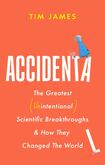
Perhaps the greatest scientific myth is that the most earth-shattering breakthroughs occur as a result of a sudden moment of brilliant insight flashing across the mind of a genius.
While it’s occasionally true that science advances following such so-called “eureka moments” it is more likely the case, argues the author of this easy-to-digest, often humorous popular science book, that our most significant discoveries arise accidentally as a result of clumsiness, misfortunes, failures and surprises.
There’s the case of the English chemist John Walker, who in 1826 accidentally scraped a stick – with which he had been stirring flammable chemicals together – against the brick hearth of his fireplace, when it ignited. He’d invented the first matchstick.
Or the story of Phineas Gage, who in 1848 was packing explosives to clear ground for a new railway track in Vermont when the powder surprisingly ignited. This shot the tamping rod he had been wielding into his skull, in gruesome fashion, just below his left eye and straight out through the top of his head.
READ MORE
Gage miraculously survived, despite having part of his brain sliced out. After the accident, however, he changed from being hard-working, capable and well-liked into a gross, profane and vulgar character. This story suggested that the brain was the seat of personality and became a foundation stone for the emerging field of neuroscience.
Then there’s the tale of Bernard Courtois, a French chemist, who in 1811 was burning seaweed, then rinsing the ashes in water to make saltpetre, a key ingredient in gunpowder. The leftover ashy sludge from this process was useless, and Courtois routinely dissolved it away carefully with sulphuric acid.
On one occasion Courtois’s hand slipped and he poured out too much acid, which reacted vigorously with the ash, and spat out a dark purple gas, which he called iodine, from the Greek word Iodes, meaning violet. From this random discovery, iodine is widely used today to produce everything from pharmaceuticals, disinfectants, printing inks and dyes to animal feed supplements and photographic chemicals.
As the author says, it is scary how often our species has “lucked out” with some of the most important life-saving inventions and profound discoveries about the universe only happening because something, somewhere, went wrong.















